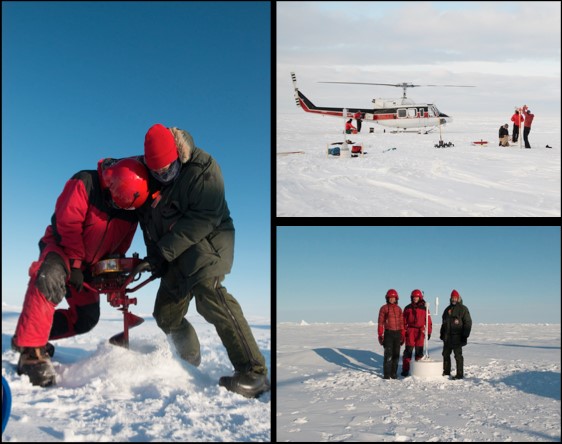IABP
The International Arctic Buoy Programme (IABP) is a joint effort between multiple international agencies to deploy and maintain Arctic buoys in the Pacific Arctic region for the purpose of collecting oceanic and meteorological data. Primarily supported by the the Arctic Research Program in NOAA’s Global Ocean Monitoring and Observing Program for the US section, IABP also receives support from other private and public agencies in other Arctic nations. These buoys are an important component of Arctic research and will continue to be crucial for real-time meteorological predictions and sea ice research in a changing Arctic environment.
The IABP data are released to the operational community through the World Meteorological Organization (WMO) and Intergovernmental Oceanographic Commission (IOC) Global Telecommunication System (GTS) in near-real time for forecasting weather and ice conditions, and to the research community from 1979- present, through the IABP data page. The IABP buoys measure surface air pressure, temperature, sea level pressure, and ice movement. These buoys sit on sea-ice or sit in the open ocean. They have several sensors such as a barometers that measure atmospheric pressure; thermistor that measures temperature; anemometers that measure wind speed; and data loggers that transmit the data to researchers via satellite in real time. Because many different agencies contribute to the program, other agencies often add other instruments for data collection to the buoys, in addition to standard pressure and temperature data collection. Much of this data is updated daily on the IABP website and is publicly available.
Buoys of the U.S. section of IABP are often deployed by extension of Naval and Coast Guard Aircraft, or by a Coast Guard Icebreaker. Researchers decide where to deploy buoys based on the geographic location of ocean processes, and where the status of sea-ice may be changing. For the most part, buoys are deployed in the same general geographic area, although the program is working on expanding to the more remote areas in the Bering Sea. Currently, IABP maintains 200 reporting buoys in the Arctic Ocean. Most of the buoys are placed on sea ice, but some are placed in open water as well. These buoys have an average life-span of 18 months.
The data collected is used for real time operations and long term research. Real time operations include collecting oceanic data for meteorological predictions. IABP buoys have helped to predict the trajectory of storms off the coast of Alaska that otherwise would have been difficult to predict. Data collected by IABP buoys is also important for forecasting sea-ice conditions, which are crucial for coastal Alaskans, subsistence fishing and those who work in the coastal commercial industry. Every summer, when Arctic sea ice retreats, shipping traffic in the Arctic region increases dramatically. Knowing the status of sea ice is critical for navigating the Arctic Ocean. Although overall summer sea ice conditions have declined, hazards still exist. A combination of sea level pressure, surface air temperature, and sea ice motion help forecasters better predict the movement of Arctic Ocean sea ice.
IABP buoys can also be used to validate satellite forecasting and complement their data findings. Having real data from the ground can greatly enhance predictability and forecast estimates for weather in the Arctic. The National Weather Service (NWS) and the National Snow and Ice Data Center (NSIDC) also use buoy data for weather predictions and ice charting in the Arctic Ocean. Data from IABP is also used for atmospheric reanalysis studies. Data collected from IABP is a keystone part of Arctic data collection. Much of the data collected supports efforts for the World Climate Research Programme and the World Weather Watch Programme. To date more than 1300 papers have been written using data from IABP.
IABP is an extensive and collaborative project. Contributors to the U.S. section of IABP include U.S. Coast Guard, DOE, NASA, Navy, NSF, and researchers from academic institutions such as the Woods Hole Institution and the University of Washington’s Polar Science center. Researchers from private and public organizations from the U.S. as well as France, Norway, China, Canada, Japan, South Korea, India, and Russia contribute to this program.
Many organizations contributing to IABP own their own icebreakers and deploy buoys. Participants of IABP meet every year to ensure that collaborative resources are being used efficiently. With so many communities contributing to the program, IABP is able to cover much of the Arctic oceans and collect an immense amount of data, helping to create a large picture of the Arctic ecosystem. These observations provide the longest continuing record for the Arctic and have been one of the cornerstones for environmental forecasting and studies of climate and climate change.
